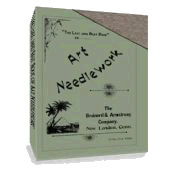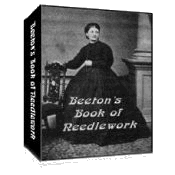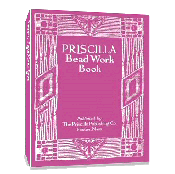Huckaback Embroidery
Huckaback Embroidery, also known as Swedish Embroidery, was popular around the 1890’s and then the interest dwindled. Around 1904, interest in this embroidery began growing again and by 1909, it became THE embroidery to do. It was no longer the expensive type of embroidery it had been in the late 1800’s when the embroidery was done with silk floss or rope silk. By 1904, mercerized cottons could be found in every color and in all degrees of thickness. The Huckaback fabric had also undergone some changes. It now could be purchased in colors other than white or cream.
“They never wear out and hold their beauty" is what embroiderers in 1909 said of designs stamped on the huckaback material. It was (and still is) a strong, durable cloth, which would stand repeated launderings and still keep its bright and fresh appearance. The designs on this cloth, which were so popular at that time, had large open patterns, the embroidery was simple, quick and easy and the finished result was very beautiful, as can be seen on the centerpieces in Colored Plate below.

The most characteristic feature of this style of work consists in the treatment of the background, which is worked in Darning Stitch, in the shades of silk that will best harmonize with the main part of the embroidery. Huckaback is admirable adapted for the employment of this stitch. In working the stitch, the floss is carried across the pattern, like the running stitch in sewing, with a short stitch beneath the surface and a little longer stitch above. The next row of stitches lies parallel with this, with a narrow space between. The beauty of the work lies in the fact that the stitches of one line come opposite the spaces of the preceding line, and this alternation is carried out with each line added until the space is filled (See Illustration).

There is no intersection of lines in this stitch, but when the linen and stitches are regularly placed, the effect is exceedingly pleasing.
Although the aforementioned manner was often used, there were no special rules for the darning effect. Victorian embroiderers found it could be used in many novel ways, much to their delight. Often the background only was darned in, the design being worked in outline and left with the white huckaback showing.
Other stitches employed with Huckaback Embroidery were most often the simple stitches like outline or buttonhole.
Although little shading is necessary, designs were frequently outlined in three tones of any given color, the darkest on the outside or bottom and the lightest toward the center or top. The background was darned in a fourth and lighter tone.
Shaded flosses became available around 1909, giving embroiderers another avenue to achieve pleasing results.
Huckaback Embroidery became so popular that it became the fashion for a girl to make her beau a darned huckaback waistcoat. It supplanted the knitted silk tie as a favored gift. The waistcoats were not only done white on white, but also embroidered in two or three colors on both white and colored huckaback.
It was suggested that to achieve a full, raised effect on vests, silks or rope silk be used, however, mercerized cotton could be used and still achieve stunning results.
If girls did not wish to make vests for the men in their lives, four-in-hand ties, with belts to match, darned on a thin huck in filo silk or mercerized cotton were suggested. In 1909, these were predicted to be the fashionable items of the season.
Today, Huckaback material can be found in many craft stores. If you can’t find it on bolts, trying looking in the craft section. Often you will find it prepackaged there. It has well defined vertical floats in the weave that makes the darning extremely easy. A tapestry needle is used and the thread is taken under every other float, not through the fabric as in most embroidery. Threads most often used are #3 and #5 pearl cottons and stranded cottons. Wools and embroidery cottons are sometimes used. Metallic threads can add a festive touch to holiday items. Although, traditionally, Huckaback embroidery was done on one side of the material only with the stitches running all the same way, many of today’s embroiderers like to stitch on both sides of the material, run the stitching both vertically and horizontally, or both. Like the Victorians before them, they are finding new ways to use this versatile, yet simple, type of embroidery.
Return to top of Huckaback Embroidery page.
Return to Victorian Types of Embroidery page.
Return to Home page.



 433 pages!
433 pages!

